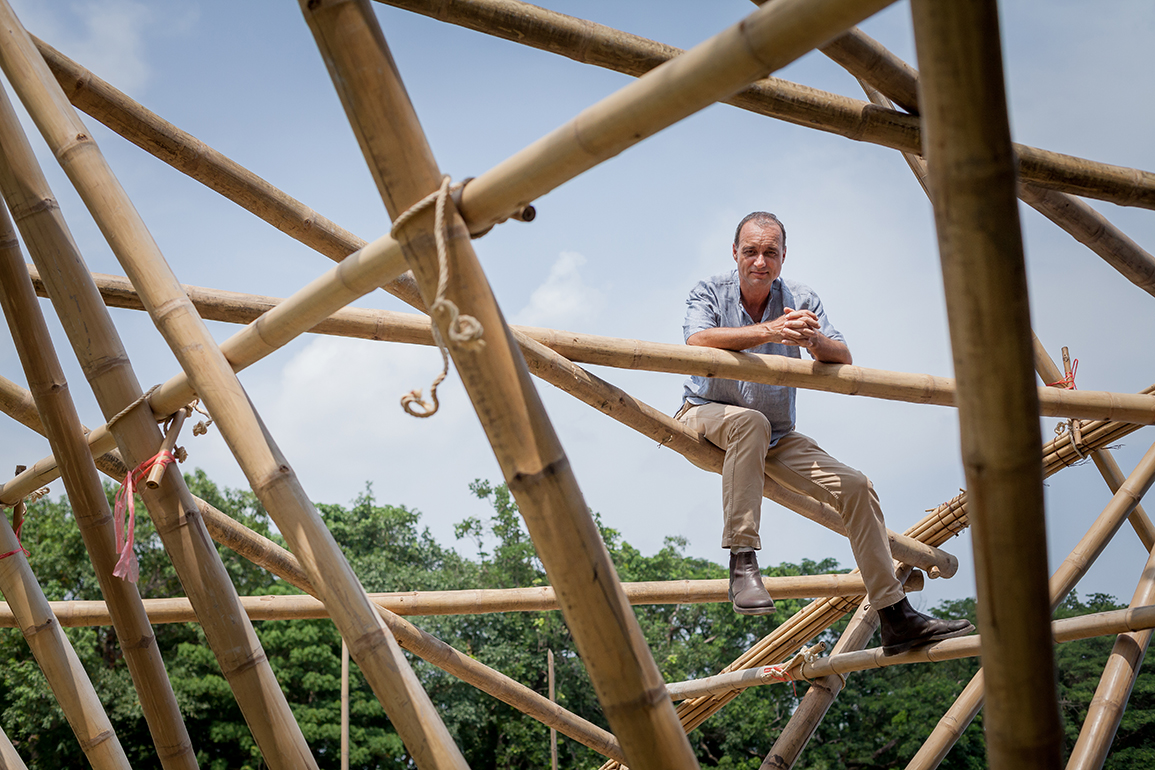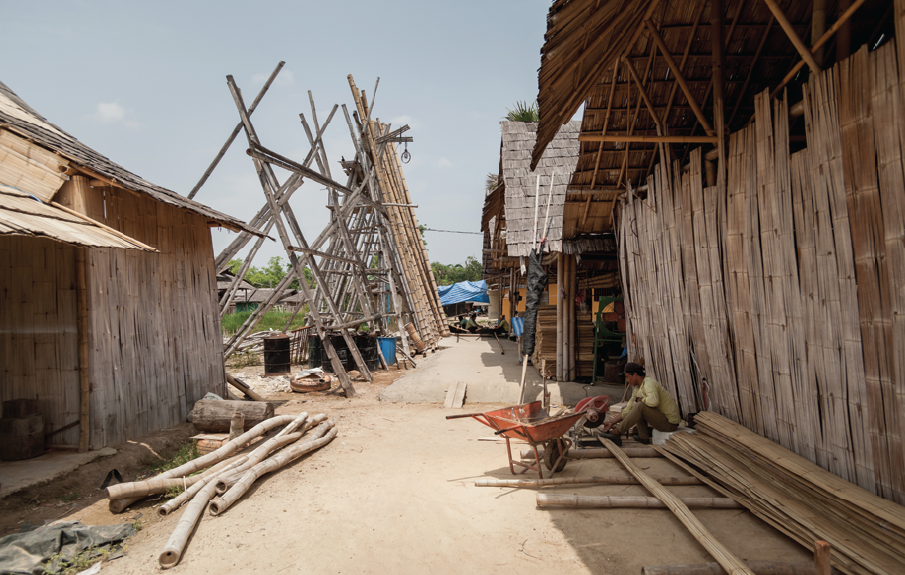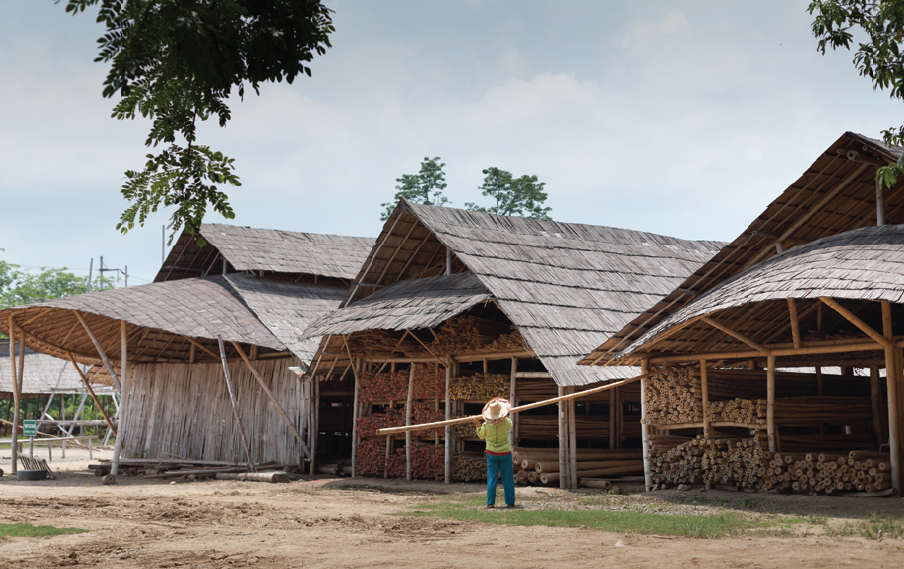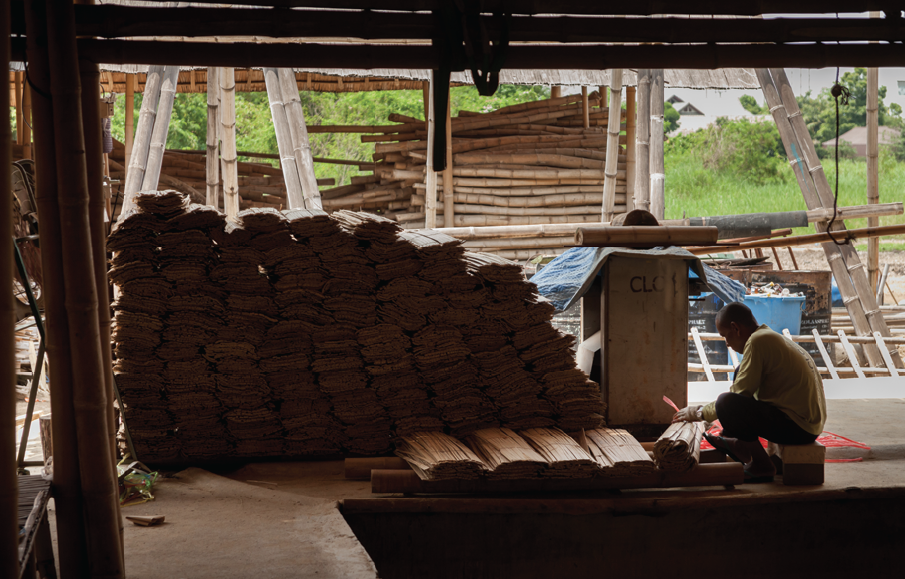WHAT WE TALK ABOUT WHEN WE TALK ABOUT BAMBOO ARCHITECTURE WITH MARKUS ROSELIEB OF CLC
TEXT: PAPHOP KERDSUP
PORTRAIT & PHOTO: KETSIREE WONGWAN EXCEPT AS NOTED
(For English, please scroll down)
8 ปีหลังจากที่ art4d ฉบับที่ 184 ได้ตีพิมพ์บทความ How green is our education? นำเสนอผลงานการออกแบบสถาปัตยกรรมจากดินและไม้ไผ่ของโรงเรียนนานาชาติปัญญาเด่น ที่ตั้งอยู่ในอำเภอหางดงไม่ไกลจากตัวเมืองเชียงใหม่สักเท่าไหร่ เรากลับไปเยี่ยมเยียนผลงานที่ว่ากันอีกครั้งหลังจากที่มีข่าวว่าโรงเรียนโดนน้ำท่วมได้รับความเสียหายไปเมื่อช่วงสองปีก่อน แต่ดูเหมือนว่า…ตลอดช่วงเวลาที่ผ่านมา รวมทั้งอุทกภัยที่เพิ่งจะผ่านไปได้หมาดๆ จะไม่ได้มีผลอะไรกับตัวสถาปัตยกรรม และความสัมพันธ์ที่มันสร้างขึ้นกับธรรมชาติรอบตัวได้สักนิดเดียว ครั้งนี้เราเลยถือโอกาสแวะเวียนกลับไปพูดคุยกับ Markus Roselieb ผู้ร่วมก่อตั้งโรงเรียน และผู้อยู่เบื้องหลังการก่อสร้างกลุ่มอาคารเรียนตั้งแต่เริ่มต้นภายใต้ชื่อ Chiangmai Life Construction (CLC) กันอีกครั้งถึงเรื่องราวของดินและไม้ไผ่ ที่ CLC เป็นหนึ่งในคนกลุ่มแรกที่บุกเบิกเส้นทางให้มันได้ถูกนำไปใช้ในการออกแบบสถาปัตยกรรมร่วมสมัยอย่างที่เราเห็นกันทุกวันนี้
“คนชอบคิดว่าไม้ไผ่เป็นวัสดุของคนจน เชย แล้วใช้ไปไม่นานก็เริ่มมีละอองตกลงมาทำให้พื้นที่ข้างในสกปรกอีก ทั้งที่จริงๆ แล้วปัญหาพวกนี้มันไม่ได้อยู่ที่ไม้ไผ่เลย แต่เราเอามันมาใช้กันไม่ถูกวิธีเองต่างหาก” Roselieb เริ่มต้นเล่าถึงภาพจำและความเข้าใจผิดที่คนส่วนใหญ่มีต่อ “ไม้ไผ่” จนทำให้หลายครั้งก็มองข้ามข้อดีที่ซ่อนอยู่ของพืชที่โตเร็วที่สุดในโลกนี้ไป ก่อนจะเสริมว่าวิธีที่เราเลือกตัดไม้ไผ่มาใช้กันแบบลวกๆ ทุกวันนี้ เป็นสาเหตุหนึ่งเลยว่าทำไมเราถึงไม่ค่อยได้วัสดุก่อสร้างที่แข็งแรงมาใช้กันแต่ได้เป็นมดปลวกที่มาทำรังและกินไม้ไผ่จนโครงสร้างเสียหายแทน “คนมักจะชอบเลือกตัดเอาต้นที่อยู่นอกๆ ของกอออกมาใช้กัน เพราะเห็นว่าสีเขียวกับผิวเงาๆ ของไผ่นี้มันสวยดี แล้วก็คิดว่านี่แหละ ดีแล้ว แต่จริงๆ คือเรากำลังเอาไม้ไผ่ต้นอ่อนๆ ที่มีแต่ไฟเบอร์และน้ำตาลอยู่ข้างในเต็มไปหมดมาใช้กันก่อนที่มันจะแก่พอเป็นโครงสร้างที่แข็งแรงได้ ซึ่งมันแทบไม่ต่างอะไรกับการเอาเค้กมาสร้างบ้านเลย”
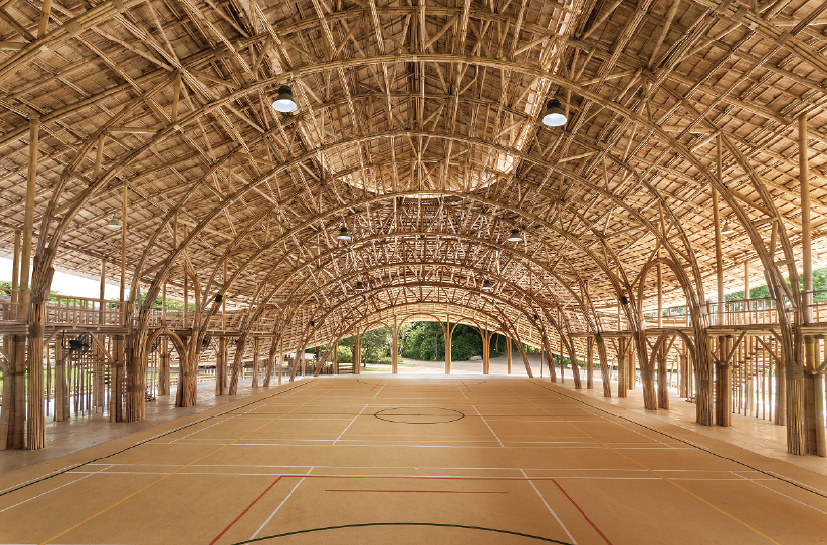
Photo courtesy of Chaingmai Life Construction
เกือบ 10 ปีแล้ว ที่ Roselieb กระโดดข้ามสายจากการเป็นแพทย์ที่ออสเตรีย มาจับดินและไม้ไผ่อยู่ที่เชียงใหม่ (และจังหวัดอื่นๆ ทั่วประเทศไทย) เขาเล่าว่า CLC เกิดขึ้นมาไล่เลี่ยกันไม่นานหลังจากที่ภรรยาของเขา ยอดเพชร สุดสวาท อดีตนักโฆษณาผู้ร่วมก่อตั้ง Phenomena เริ่มมีความคิดที่จะสร้างโรงเรียนวิถีพุทธขึ้นมาในเชียงใหม่ในปี 2009 ในช่วงเวลาเดียวกันกับที่ประเทศไทยได้เป็นเจ้าภาพจัดงานประชุมวิชาการว่าด้วย “ไม้ไผ่” ที่สำคัญที่สุดงานหนึ่งของโลกอย่าง World Bamboo Congress ครั้งที่ 8 ซึ่งก็ยิ่งช่วยเพิ่มความสนใจที่มีต่อไม้ไผ่ให้กับ Roselieb ขึ้นไปอีก ประกอบกับความต้องการที่จะปลูกฝังให้เด็กๆ ในโรงเรียนได้มีโอกาสใกล้ชิดกับธรรมชาติผ่านทั้งหลักสูตรและสภาพแวดล้อม
การระดมผู้เชี่ยวชาญมาให้คำปรึกษาในด้านต่างๆ ไม่ว่าจะในเรื่องของการใช้ดินและไม้ไผ่อย่างถูกวิธี หรือการก่อสร้างที่ได้ 24H Architecture จากเนเธอร์แลนด์มาช่วยออกแบบในขั้นต้น โดยมี CLC รับหน้าที่เป็นผู้รับเหมาโครงการ จึงเริ่มต้นขึ้นและแล้วเสร็จเป็นสถาปัตยกรรมออร์แกนิกของโรงเรียนนานาชาติปัญญาเด่นในที่สุด จนสร้างความฮือฮาให้กับวงการออกแบบทั้งในบ้านเราและนานาชาติ ถึงขนาดที่ Frank Gehry ต้องบินข้ามน้ำข้ามทะเลมาดูสิ่งที่ Roselieb นิยามว่าเป็น สถาปัตยกรรมไม้ไผ่สมัยใหม่ (Modern Bamboo Architecture) และความไม่ธรรมดาที่ซ่อนอยู่ในวัสดุพื้นถิ่นนี้
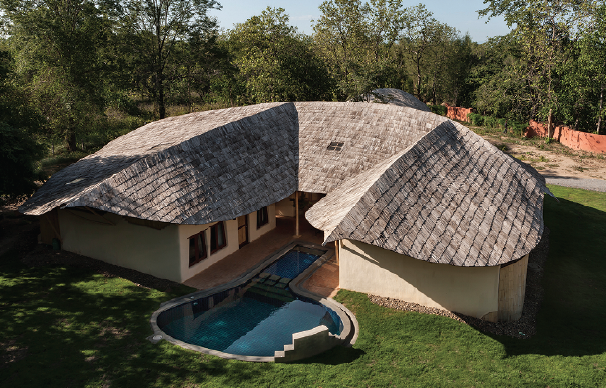
Photo courtesy of Chaingmai Life Construction
“ผมอยากจะให้ไม้ไผ่ถูกนำมาใช้ในการก่อสร้างของศตวรรษที่ 21 มากขึ้น เพราะคนส่วนใหญ่ชอบมองว่าวัสดุธรรมชาตินี้มันไม่มีคุณค่าพอ ทั้งๆ ที่มันสู้กับวัสดุก่อสร้างที่มีอยู่ในท้องตลาดตอนนี้ในแง่ของฟังก์ชั่นได้ไม่แพ้กันเลย มันน่าเสียดายที่การขาดความรู้ที่ถูกต้องทำให้คนคิดว่าไม้ไผ่เป็นวัสดุก่อสร้างที่ไม่แข็งแรง” Roselieb แนะนำว่าหลักสำคัญๆ สามข้อที่เราควรรู้หากจะนำไม้ไผ่มาใช้ในการออกแบบและก่อสร้าง คือ จะต้องรู้ว่ามันอายุเท่าไหร่ จะนำชนิดไหนมาใช้ และจะนำมันไปใช้อย่างไร ก่อนจะขยายความว่าไม้ไผ่ที่อายุ 4-6 ปีนั้นเป็นช่วงที่เหมาะกับการนำมาใช้ก่อสร้างที่สุดเพราะมีความยืดหยุ่นเพียงพอ โดยปกติแล้วไม้ไผ่จะโตเต็มที่ที่ 180 วัน เพราะฉะนั้นแล้วขนาดเส้นผ่านศูนย์กลางเล็กใหญ่ที่เราเห็นว่าต่างกันนั้น ไม่ได้เป็นเพราะอายุอย่างที่เราคิดกัน แต่เป็นเพราะความต่างของสายพันธุ์ ส่วนสิ่งที่เกิดขึ้นกับไม้ไผ่ที่อายุต่างกันคือความหนาแน่นของเนื้อที่อยู่ภายใน “เราไม่ได้ใช้ตะปูหรือสกรูไม่ใช่เพราะว่าเราอยากจะทำตัวล้าสมัย แต่เราพบว่าการยึดไม้ไผ่เข้าด้วยกันด้วยเดือยกลมไม้ไผ่ (bamboo dowel) มันแข็งแรงกว่า เพราะมันไม่เกิดรอยแตก แต่ถ้าเราใช้ตะปูหรือสกรูตอกเข้าไปมันจะทำให้เกิดรอยแตกขึ้น และนั่นจะยิ่งทำให้โครงสร้างมันไม่แข็งแรง” Roselieb กล่าวเพิ่มเติม
ผลงานในช่วง 3-4 ปีมานี้ของ CLC และ Chiangmai Life Architects ที่ Roselieb ก่อตั้งเพื่อให้เกิดความครบวงจรมากขึ้นในการออกแบบและก่อสร้าง มีความเปลี่ยนแปลงไปพอสมควร โดยนอกจากวิธีการทำงานกับไม้ไผ่ที่มีหลักการมากยิ่งขึ้น ซึ่งจะเห็นได้จากภายในบริเวณพื้นที่การทำงานของ CLC ที่จะมีโรงเรือนสำหรับใช้คัดแยกขนาด และเตรียมไม้ไผ่ด้วยการแช่น้ำผสมเกลือบอแรกซ์และกรดบอริก เพื่อให้ความเค็มจากน้ำไล่น้ำตาลในไม้ไผ่ให้หมดไปแล้วการนำหลักวิศวกรรมมาใช้เพื่อให้ผลงานได้มาตรฐานความปลอดภัยก็เป็นอีกสิ่งที่เราเห็นได้ชัดเจนเช่นกัน โดยเฉพาะในอาคารศูนย์กีฬาของโรงเรียนนานาชาติปัญญาเด่นขนาดเกือบ 800 ตารางเมตรที่เพิ่งจะเสร็จไปได้ไม่นาน ซึ่ง Roselieb เล่าว่าโครงสร้าง truss ไม้ไผ่ที่เห็นนี้ ได้วิศวกรมาช่วยคำนวณน้ำหนักบรรทุก (load) แรงดึง (tension) รวมทั้งแรงเฉือน (shear force) ต่างๆ ของอาคารเพื่อกำหนดจำนวนไม้ไผ่ที่ต้องใช้จริงๆ ในงาน “สมมติว่าผมอยากจะให้เขาช่วยคำนวณจำนวนไม้ไผ่ให้กับโครงสร้างหนึ่งให้เขาจะไม่ได้มาบอกว่าใช้ไม้ไผ่ประมาณเท่าไหร่ แต่จะบอกเลยว่าต้องใช้ไม้ไผ่กี่ต้น ขนาดเท่าไหร่ ซึ่งนี่คือข้อดีของการมีวิศวกร มันถูกต้องและแม่นยำ” เป็นเรื่องน่าสนใจเหมือนกันตอนที่ Roselieb เล่าว่านอกจาก Phuong Nguyen และ Esteban Morales Montoya ที่เขาใช้ช่วยคำนวณแล้ว ตอนนี้มีวิศวกรที่เชี่ยวชาญการคำนวณโครงสร้างไม้ไผ่โดยเฉพาะอยู่แค่หยิบมือเท่านั้นเอง

สำหรับเราแล้ว สิ่งที่ทำให้ CLC ต่างออกไป ไม่ใช่แค่การหยิบเอาวัสดุจากธรรมชาติมาใช้สร้างสถาปัตยกรรมออร์แกนิกที่มีความสอดคล้องไปกับบริบทและใช้งานได้จริง แต่คือการพัฒนาตัวเองและเรียนรู้อย่างจริงจังของ Roselieb ที่ทำให้จากคนที่ไม่เคยรู้จักสิ่งที่เรียกว่าไม้ไผ่มาก่อน สามารถสร้างสรรค์ผลงานอย่างที่เราเห็นกันทุกวันนี้ได้ “ผมเป็นคนหนึ่งเลยที่เชื่อแนวคิดเรื่อง ‘การเรียนรู้โดยการลงมือทำ’ คือผมเรียนมาเยอะมากจนรู้ว่าสิ่งที่สำคัญยิ่งกว่ามันคือการได้ลงมือทำ และถ้าคุณสนใจอะไรบางอย่างแล้วได้ลงมือทำมันจริงๆ คุณจะเริ่มตั้งคำถามและเรียนรู้จากมันไปโดยอัตโนมัติเอง สิ่งที่ CLC กำลังพยายามทำอยู่ทุกวันนี้ คือการได้ลงมือทำอะไรสักอย่าง เพื่อให้มันได้ช่วยเปลี่ยนโลกไปอีกทาง”

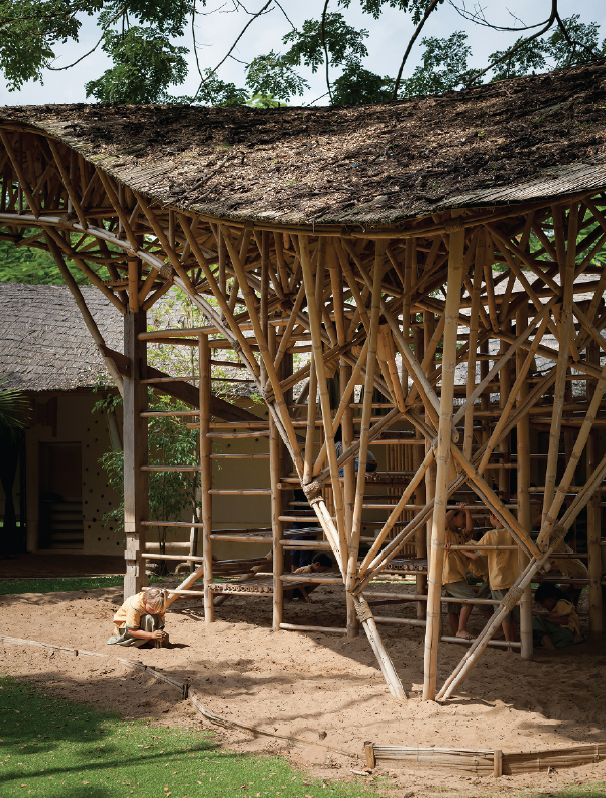
It has been eight years since art4d first published the article ‘How green is our education?’ in the 184th issue and featured in it is the architectural design of the earth and bamboo buildings of Panyaden International School, located in Hang Dong district not too far from Chiang Mai’s city center. We revisited the school after hearing about last two year’s flood in Hang Dong, wondering what damage the water might have caused. But as it turns out, the architecture of the school, as well as the relationship it has formed with the surrounding environment, was not in any way affected by the flash flooding. We also took this chance to talk with Markus Roselieb, the school’s founder and the mind behind Chiangmai Life Construction (CLC), who made the construction of this amazing architectural structure possible, about earth and bamboo, and the story of the pioneering days where CLC was blazing the trail before these materials were being picked up by the contemporary architectural design we see today.
“People think that bamboo is a poor people’s material because its life expectancy is short and leads to unpleasant debris that messes up the interior space. The truth of the matter is, these problems don’t come from bamboo but from the wrong ways that it has been used,” Roselieb began by explaining the misconception people have for ‘bamboo,’ which causes the world’s fastest growing plants to be overlooked as a strong and sustainable construction material. He adds that the careless and unrefined use of bamboo is one of the reasons why we haven’t been able to develop a substantial and solid material out of it, and instead end up building a structure that would eventually be eaten up by termites and ants. “People tend to choose the outermost stems because the green and clean texture is nice-looking, and they think they have it right, but actually they’re using the young stems that are full of fiber and sugar contents, way before their time, instead of letting them grow enough to be used in the construction of an architectural structure. It’s like building a home using sponge cake.”
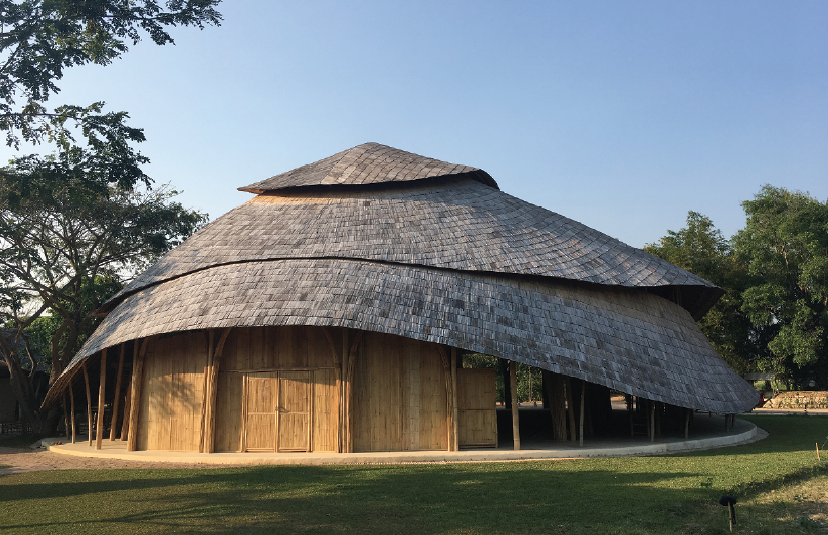
Photo courtesy of Chaingmai Life Construction
For the almost ten years that Roselieb stepped out of his career path as a doctor in Austria to work with the earth and bamboo in Chiang Mai (and other provinces across Thailand), he recalled how CLC came into existence after his wife, Yodphet Sudsawad, the former advertising creative and founder of renowned Bangkok-based agency, Phenomena, was inspired by the idea of establishing a holistic pre-school and primary school in Chiang Mai by integrating Buddhist values into a school. It was 2009 when the thought was beginning to materialize and it was at that same time that Thailand was hosting the 8th World Bamboo Congress, one of the world’s most important academic forums about bamboo. Having participated in the congress, the knowledge ignited Roselieb’s interest in the material. He wished to educate children in the school through their close connection with nature, which is not only included as a part of the academic curriculum but the school’s built environment. Experts were called in to provide ideas and advice about the proper and efficient use of earth and bamboo, including 24H Architecture from the Netherlands who was asked to work on the preliminary design with CLC acting as the project’s contractor. The project was initiated and completed with the organic architecture of Panyaden International School being the final result. The work attracted the interest of the local and international design community to the point where Frank Gehry flew to Chiang Mai to see what Roselieb defined as ‘Modern Bamboo Architecture’ and all the extraordinary elements hidden in this simple local material.
“I want bamboo to be used more in the construction of built structures in the 21st Century. Most people look at this natural material and think of it as something that has inferior value despite the fact that it has tremendous potential compared to other materials available on the market. It’s a shame that the lack of the right know-how makes people view bamboo as an inefficient construction material.” Roselieb explained that the three main principles one should know when bamboo is being used in the design and construction of architecture are the age, the type and the application. He further elaborated that a bamboo stem at the age of 4-6 years is ideal as a construction material for it contains sufficient flexibility. Normally, it takes 180 days for bamboo to fully grow. The diameter isn’t an indicator of a stem’s age like many think, for the varying species of bamboo are what make their stems bigger or smaller. What differentiates bamboos is the density of it’s texture. “We don’t use any nails or screws not because we intend to stay obsolete but because we found that the joints that use bamboo dowels are much stronger for they don’t render fractures, which is something a nail or a screw can easily cause and eventually results in the instability of the overall structure.”
The works created over the past couple of years by CLC and Chiangmai Life Architects, which Roselieb founded to provide more comprehensive design and construction services, have changed quite considerably. As CLC continues to develop more tangible principles and construction know-how, what we saw from this visit was bamboo stems being properly categorized into sizes on the grounds of CLC’s workshop before being soaked in borax salt and a boric acid solution where the saltiness helps to get rid of the sugar contents. Engineering principles are incorporated for bamboo structures to attain a greater safety standard, particularly with the construction of the recently completed Panyaden’s 800-square-meter sports hall. Roselieb tells us that the bamboo truss of the structure has engineers calculating the load, tension, and shear forces the building has to carry, allowing for the exact amount of bamboo needed for the construction to be indicated. “Let’s say I want them to help calculate the amount of bamboo needed for the construction of a structure, they won’t tell me the rough but exact number of stems we need to prepare, including the sizes. This is the great thing about having engineers working with us because everything is correct and precise.” It’s interesting when Roselieb talks about how there’s only a limited number of engineers who are considered to be experts in bamboo structures, in addition to Phuong Nguyen and Esteban Morales Montoya, whom he invited to help with his projects.
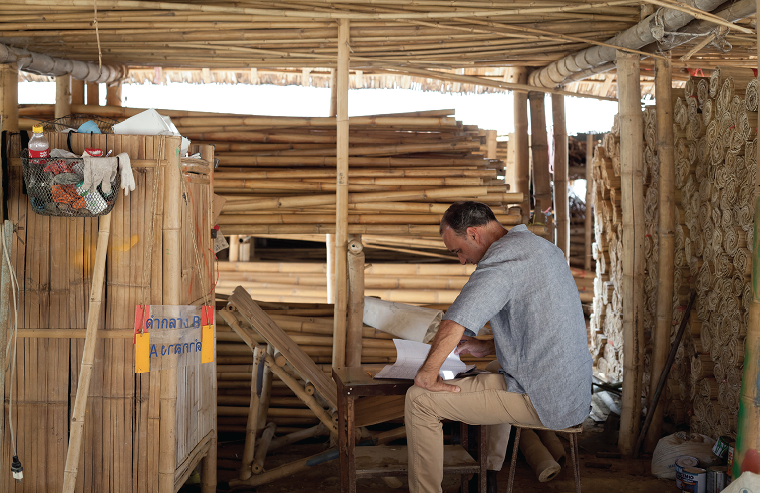
For us, what makes CLC different isn’t just their impressive use of natural materials in the construction of organic architecture that corresponds so beautifully with the context and functional requirements, but the way that the company and Roselieb continue to develop and learn, allowing for them to use the material that they once had no knowledge of to create something of such a level of inventiveness. “I’m very much a believer of ‘learning by doing’.’ I have studied so much that I finally realized that the more important thing is to actually do it. And if you’re interested in something and you get your hands on it, you automatically begin to question and learn from it. What CLC is trying to do today is to do something that can help change the world, in one way or the other.”

